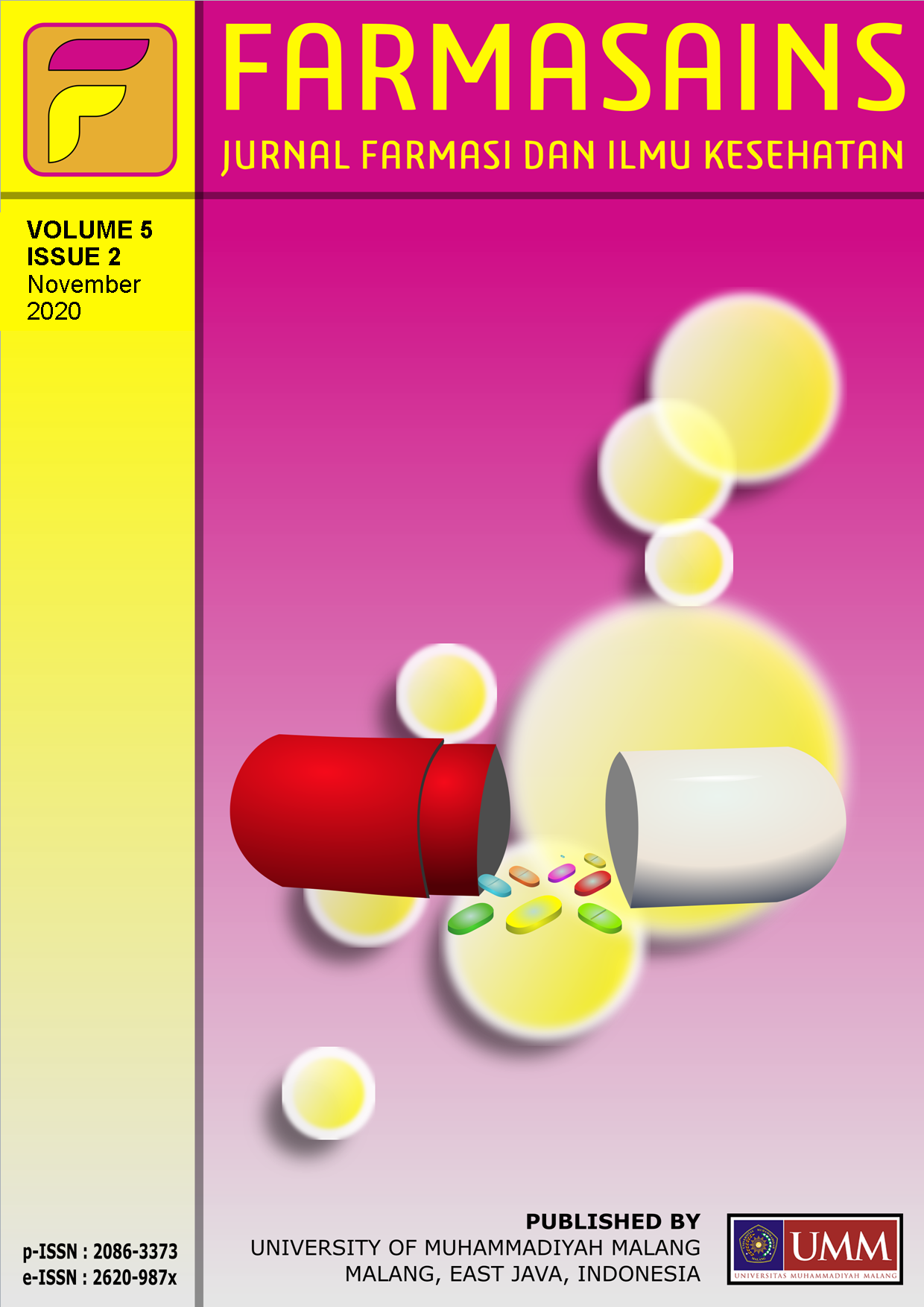Behavioral factor analysis of accuracy in using diarrhea medicines at Arjuno Health Center, Malang City with the Health Belief Model (HBM) approach
DOI:
https://doi.org/10.22219/farmasains.v5i2.14094Keywords:
Accuracy, Diarrhea medication, Health Belief ModelAbstract
Diarrhea is a bowel movement that can occur in adults and children, with a frequency of three or more times a day, accompanied by stool to liquid changes, with mucus and blood. The Health Belief Model is a theory used to help identify factors that influence individual health behavior. This study aims to analyze patient behavior factors that influence the accuracy in using diarrhea medication at Arjuno Health Center Malang City, according to the HBM approach. This study used a cross-sectional method with the sampling technique used, namely a non-probability sample with an accidental method. This study uses an approach to the theory of the Health Belief Model (HBM). The research instrument used was a valid and reliable questionnaire. There are two variables used, namely the independent variable (the factors of the Health Belief Model theory) with five constructs, namely Perceived susceptibility, perceived severity, perceived barrier, perceived benefits, self-efficacy. Furthermore, the dependent variable with one indicator is the accuracy of using diarrhea medication. The number of samples used was 80 respondents. The T-test with a significance value for each HBM component is 0.000 < p-value (alpha = 0.05), which means an influence between each HBM component and the accuracy of drug use in patients with diarrhea. F test with a significant value for all HBM components 0.000 < p-value (alpha = 0.05), which means that there is an effect of all HBM components on drug use accuracy in patients with diarrhea.
Downloads
References
Chalik, R., Ratnah, S., & Karim, D. (2018). Identifikasi Drug Related Problems (DRPs) dalam Pengobatan Diare pada Pasien Anak Rawat Inap di Rumah Sakit Umum Daerah Labuang Baji Makassar. Media Farmasi, 14(1), 35-38. doi:10.32382/mf.v14i1.83
Donsu, J. D. T. (2016). Metodologi Penelitian Keperawatan. Yogyakarta, Indonesia: Pustaka Baru.
Handayani, R., & Arsiani, N. M. J. (2015). Faktor-Faktor yang Mempengaruhi Diare pada Balita Usia 0-59 Bulan di Puskesmas Gedangan Kecamatan Gedangan Kabupaten Malang. 3, 9-21.
Mafazah, L. (2013). Ketersediaan sarana sanitasi dasar, personal hygiene ibu dan kejadian diare. KEMAS: Jurnal Kesehatan Masyarakat, 8(2). doi:10.15294/kemas.v8i2.2819
Muflihah, A. (2015). Uji Validitas Konstruk Instrumen Health Belief Model dan Dukungan Sosial dengan Metode Confirmatory Factor Analysis (CFA). Jurnal Pengukuran Psikologi Dan Pendidikan Indonesia, 4(2), 97-112. doi:10.15408/jp3i.v4i2.9286
Nugraha, S., & Nurhayati, R. (2015). Hubungan Health Belief dengan Perilaku Compliance pada Pasien Gagal Ginjal Kronis di RSUD Al Ihsan. Prosiding Psikologi, 1(2), 30-39. doi:10.29313/.v0i0.988
Prawati, D. D., & Haqi, D. N. (2019). Faktor yang mempengaruhi kejadian diare di Tambak Sari Kota Surabaya. Jurnal Promkes: The Indonesian Journal of Health Promotion and Health Education, 7(1), 34-45. doi:10.20473/jpk.v7.i1.2019.35-46
Rahayu, O. (2014). Gambaran Praktek Pemberian Rehidrasi Oral pada Balita Diare di Wilayah Kerja Puskesmas Kotabaru Kota Bekasi Tahun 2014 . (Undergraduate’s Thesis). University of Indonesia, Depok, Indonesia.
Setia, M. S. (2016). Methodology series module 3: Cross-sectional studies. Indian Journal of Dermatology, 61(3),261-264. doi:10.4103/0019-5154.182410
Setiawan, E., Iskandar, Y., & Basari, M. A. (2019). Pengaruh Degree Of Operating Leverage (Dol) Dan Degree Of Financial Leverage (Dfl) Terhadap Profitabilitas. Business Management and Entrepreneurship Journal, 1(2), 149-157.
Siswidiasari, A., Astuti, K. W., & Yowani, S. C. (2014). Profil terapi obat pada pasien rawat inap dengan diare akut pada anak di Rumah Sakit Umum Negara. Jurnal Kimia, 8(2), 183-190. doi:10.24843/JCHEM.2014.v08.i02.p07
Wibisono, A. M. (2019). Analisis faktor risiko kejadian diare berulang pada balita di Puskesmas Sumberjambe Kabupaten Jember. (Undergraduate Thesis). Universitas Negeri Jember, Jember, Indonesia. Retrieved from https://repository.unej.ac.id/bitstream/handle/123456789/90405/Anita%20Margaret%20Wibisono-152010101131.pdf?sequence=1&isAllowed=y
Downloads
Published
How to Cite
Issue
Section
License
Copyright (c) 2021 Laras Hadyaning Tias, Liza Pristianty, Ika Ratna Hidayati

This work is licensed under a Creative Commons Attribution 4.0 International License.
Authors who publish with this journal agree to the following terms:
a. Authors retain copyright and grant the journal right of first publication with the work simultaneously licensed under a Creative Commons Attribution License that allows others to share the work with an acknowledgement of the work's authorship and initial publication in this journal.
b. Authors are able to enter into separate, additional contractual arrangements for the non-exclusive distribution of the journal's published version of the work (e.g., post it to an institutional repository or publish it in a book), with an acknowledgement of its initial publication in this journal.
c. Authors are permitted and encouraged to post their work online (e.g., in institutional repositories or on their website) prior to and during the submission process, as it can lead to productive exchanges, as well as earlier and greater citation of published work (See The Effect of Open Access).













